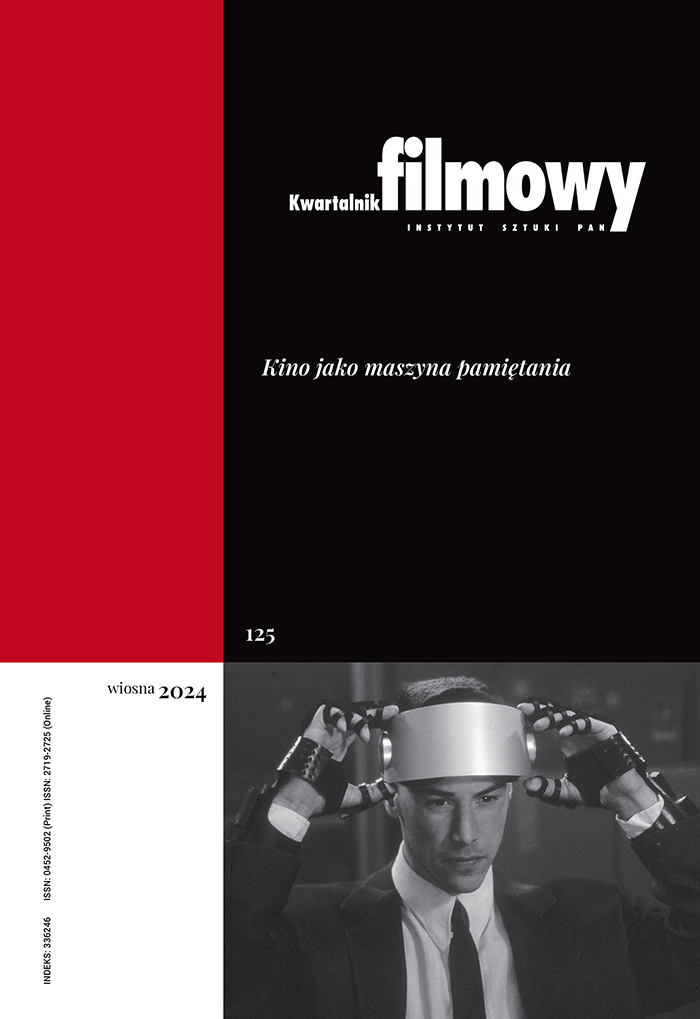Architektura, urbanistyka i wspólnota – „Byker” Sirkki-Liisy Konttinen
Karolina Kosińska
karolina.kosinska@ispan.plInstytut Sztuki, Polska Akademia Nauk (Polska)
https://orcid.org/0000-0003-1096-878X
Abstrakt
Tekst skupia się na projekcie Byker (1983) Sirkki-Liisy Konttinen – członkini kolektywu Amber z Newcastle dokumentującego życie społeczne środowisk robotniczych w północnej Anglii – który z jednej strony stanowił zapis transformacji osiedla Byker (władze miasta zdecydowały o jego wyburzeniu, a rzędy szeregowców, uznanych za slumsy, miała zastąpić nowoczesna zabudowa autorstwa Ralpha Erskine’a), z drugiej wpisywał się w żywą dyskusję na temat architektury i urbanistyki powojennej Brytanii. Kosińska stara się dowieść, że film Byker, choć nostalgiczny w tonie, jest przede wszystkim – z racji hybrydycznej formy, ale i złożonych chwytów retorycznych – próbą symbolicznego odwrócenia procesu niszczenia i (re)konstrukcji wspólnoty, przywrócenia jej kontroli nad przestrzenią. Autorka wykorzystuje tezy Annabell Honess Roe i teorie przestrzeni jako konstruktu społecznego Henri’ego Lefebvre’a, a wpisując film w kontekst urbanistyczny, sięga też do raportu Petera Malpassa rozbijającego mit sukcesu, jaki towarzyszył przebudowie Byker.
Instytucje finansujące
Słowa kluczowe:
Sirkka-Liisa Konttinen, kolektyw Amber, kino brytyjskie, realizm społeczny, architektura, urbanistyka, wspólnotaBibliografia
Beynon, H. (2001). Images of Labour/Images of Class. W: S. Rowbotham, H. Beynon (red.), Looking at Class: Film, Television and the Working Class in Britain (ss. 25-40). London – New York: Rivers Oram Press.
Google Scholar
Harvey, D. (1993). From Space to Place and Back Again: Reflections on the Condition of Postmodernity. W: J. Bird, B. Curtis, T. Putnam, G. Robertson, L. Tickner (red.), Mapping the Futures: Local Cultures, Global Change (ss. 3-29). London: Routledge.
Google Scholar
Honess Roe, A. (2007). Spatial Contestation and Loss of Place in Amber’s „Byker”. Journal of British Cinema and Television, 4 (2), ss. 307-321.
Google Scholar
Konttinen, S.-L. (1988). Byker. Newcastle: Bloodaxe Books – Amber Side.
Google Scholar
Kynaston, D. (2007). Austerity Britain. London: Bloomsbury.
Google Scholar
Lambert, G. (1956). Free Cinema. Sight & Sound, 25, s. 174.
Google Scholar
Lefebvre, H. (1991). The Production of Space (tłum. D. Nicholson-Smith). Oxford: Blackwell.
Google Scholar
Malpass, P. (1979, 16 maja). A Reappraisal of Byker. Part 2: Magic, Myth and the Architect, Architects’ Journal, ss. 1011-1020.
Google Scholar
Malpass, P. (1979, 9 maja). A Reappraisal of Byker. Part 1: Magic, Myth and the Architect. Architects’ Journal, ss. 961-969.
Google Scholar
Vall, N. (2012). Social Engineering and Particpation in Anglo-Swedish Housing 1945-1976: Ralph Erskine’s Vernacular Plan. Planning Perspectives, 28 (2), ss. 223-245. https://doi.org/10.1080/02665433.2013.737710
DOI: https://doi.org/10.1080/02665433.2013.737710
Google Scholar
Autorzy
Karolina Kosińskakarolina.kosinska@ispan.pl
Instytut Sztuki, Polska Akademia Nauk Polska
https://orcid.org/0000-0003-1096-878X
Doktor filmoznawstwa, adiunkt w Zakładzie Antropologii Kultury, Filmu i Sztuki Audiowizualnej w Instytucie Sztuki Polskiej Akademii Nauk. Redaktorka naczelna „Kwartalnika Filmowego”. Autorka książki Androgyn. Tożsamość, tęsknota, pragnienie (2015), uhonorowanej Nagrodą im. Bolesława Michałka za najlepszą książkę filmoznawczą roku. Zainteresowania naukowe: brytyjskie kino społeczne i formy filmowego realizmu społecznego.
Statystyki
Abstract views: 1441PDF downloads: 400
Licencja
Prawa autorskie (c) 2020 Karolina Kosińska

Utwór dostępny jest na licencji Creative Commons Uznanie autorstwa – Użycie niekomercyjne – Bez utworów zależnych 4.0 Międzynarodowe.
Autor bądź autorka udziela wydawcy niewyłącznej i nieodpłatnej licencji (CC BY 4.0) na wykorzystanie tekstu w „Kwartalniku Filmowym”, zachowuje nieograniczone prawa autorskie i zobowiązuje się do podawania miejsca pierwodruku przy ponownym wykorzystaniu artykułu (umowa licencyjna do pobrania). Czasopismo jest wydawane na licencji CC BY 4.0. Zgłaszając artykuł do publikacji, autor bądź autorka wyraża zgodę na jego udostępnianie na tej licencji.
W wydaniach od 105-106 (2019) do 119 (2022) wszystkie artykuły były publikowane na licencji CC BY-NC-ND 4.0. W tym okresie autorzy i autorki udzielali(-ły) niewyłącznej i nieodpłatnej licencji (CC BY-ND 4.0) na wykorzystanie tekstu w „Kwartalniku Filmowym”, zachowywali(-ły) nieograniczone prawa autorskie i zobowiązywali(-ły) się do podawania miejsca pierwodruku przy ponownym wykorzystaniu artykułu.
Inne teksty tego samego autora
- Karolina Kosińska, Od redakcji , Kwartalnik Filmowy: Nr 109 (2020): Przestrzeń architektoniczna w filmie
- Karolina Kosińska, Od redakcji , Kwartalnik Filmowy: Nr 130 (2025): Nowa gatunkowość
- Karolina Kosińska, Od redakcji , Kwartalnik Filmowy: Nr 113 (2021): Film i technologia
- Karolina Kosińska, Od redakcji , Kwartalnik Filmowy: Nr 111 (2020): Zmysły i afekty
- Karolina Kosińska, Od redakcji , Kwartalnik Filmowy: Nr 108 (2019): Produkcja i dystrybucja filmowa
- Karolina Kosińska, Od redakcji , Kwartalnik Filmowy: Nr 116 (2021): Kino i tożsamość społeczna
- Karolina Kosińska, Od redakcji , Kwartalnik Filmowy: Nr 125 (2024): Kino jako maszyna pamiętania
- Karolina Kosińska, Od redakcji , Kwartalnik Filmowy: Nr 115 (2021): Film formy, film treści
- Karolina Kosińska, Od redakcji , Kwartalnik Filmowy: Nr 119 (2022): (Nowa) teoria filmu
- Karolina Kosińska, Od redakcji , Kwartalnik Filmowy: Nr 118 (2022): Jedno ujęcie











